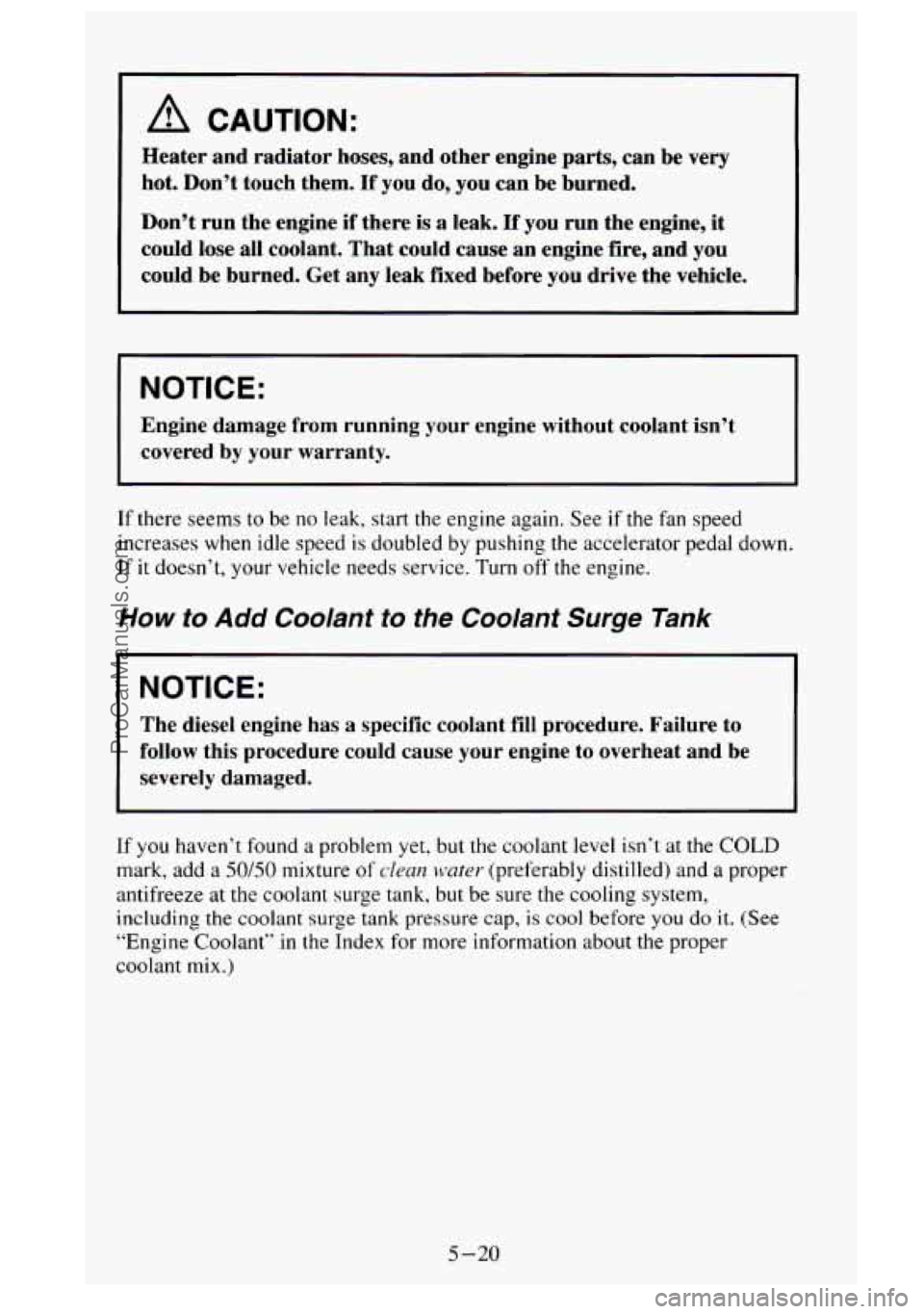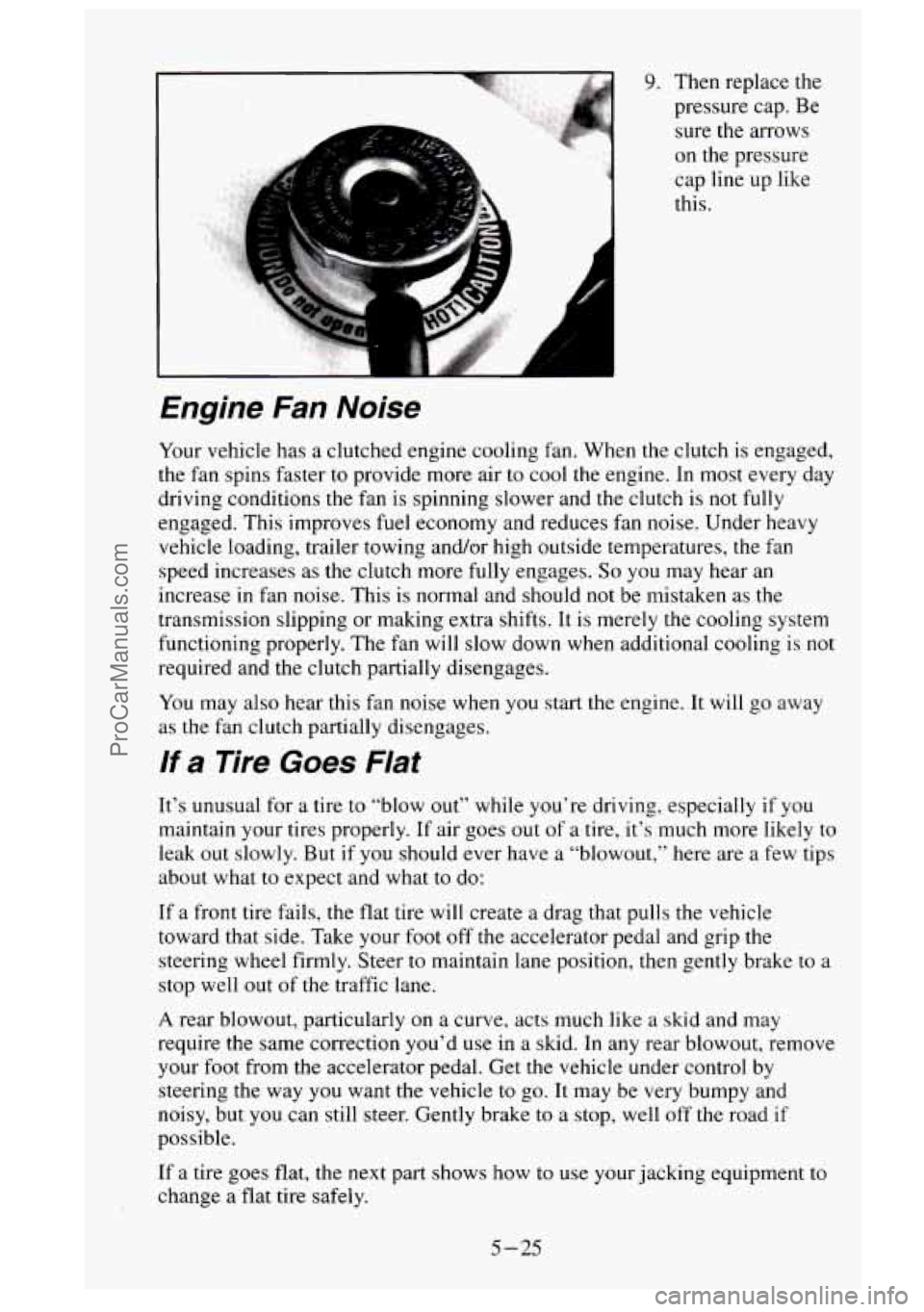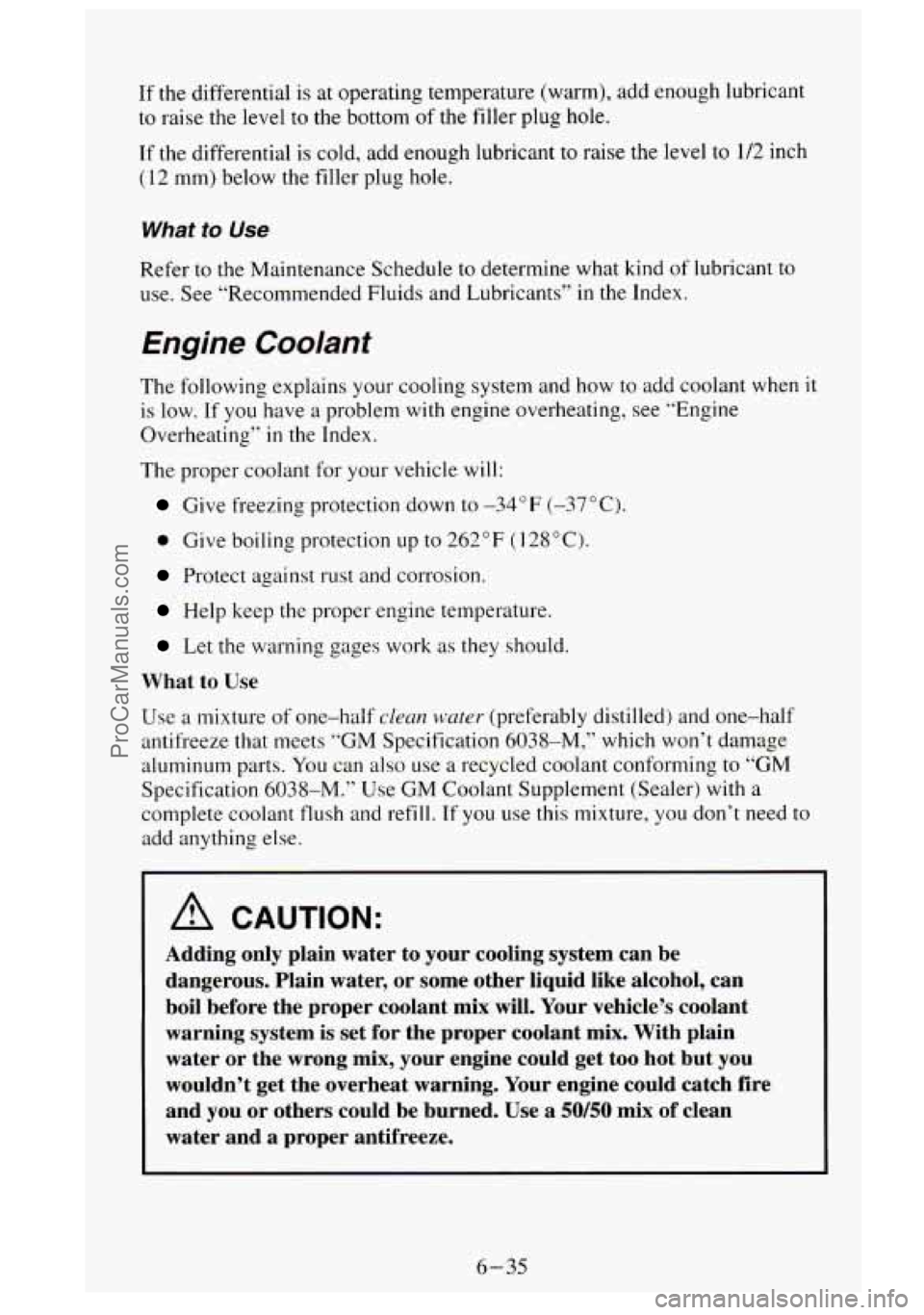Page 240 of 488
How to Add Coolant to the Radiator
r
1.
I
You can remove the radiator pressure cap when the cooling system,
including the radiator pressure cap
and upper radiator hose, is no longer
hot. Turn the pressure cap slowly
to the left until it first stops. (Don't
press down while turning the pressure cap.)
If you hear a hiss, wait for that to stop. A hiss means there is still some
pressure left.
:_. .w 2. Then keep
turning the
pressure cap, but
now push down
as you turn it.
Remove the
pressure cap.
5-16
ProCarManuals.com
Page 243 of 488
Cooling System - Diesel Engines
When you decide it‘s safe to lift the hood, here’s what you’ll see:
A. Coolant surge tank pressure cap
B. Engine fan(s)
C. Radiator
A CAUTION:
If your vehicle has air conditioning, the auxiliary electric fan
under the hood can start up even when the engine is not running
and can injure you. Keep hands, clothing and tools away from
any underhood electric fan.
If the coolant inside the coolant surge tank is boiling, don’t do anything else
until it cools down.
The coolant level
should be
at or above
the
COLD mark. If it
isn’t,
you may have a
leak in the radiator
hoses, heater hoses,
radiator, water pump
or somewhere else in
the cooling system.
5-19
ProCarManuals.com
Page 244 of 488

I A CAUTION:
Heater and radiator hoses, and other engine parts, can be very
hot. Don’t touch them.
If you do, you can be burned.
Don’t run the engine
if there is a leak. If you run the engine, it
could lose all coolant. That could cause an engine
fire, and you
could be burned. Get any leak fixed before you drive the vehicle.
I NOTICE:
Engine damage from running your engine without coolant isn’t
covered by your warranty.
If there seems to be no leak, start the engine again. See if the fan speed
increases when idle speed
is doubled by pushing the accelerator pedal down.
If
it doesn’t, your vehicle needs service. Turn off the engine.
How to Add Coolant to the Coolant Surge Tank
I NOTICE:
The diesel engine has a specific coolant fill procedure. Failure to
follow this procedure could cause your engine to overheat and be
severely damaged.
If you haven’t found a problem yet, but the coolant level isn’t at the COLD
mark, add a
50/50 mixture of cleun water (preferably distilled) and a proper
antifreeze at the coolant surge tank, but be sure the cooling system,
including the
coolant surge tank pressure cap, is cool before you do it. (See
“Engine Coolant”
in the Index for more information about the proper
coolant mix.)
5-20
ProCarManuals.com
Page 245 of 488
A CAUTION:
Steam and scalding liquids from a hot cooling system can blow
out and burn you badly. They are under pressure, and
if you
turn the coolant surge tank pressure cap
- even a little - they
can come out at high speed. Never turn the cap when the cooling
system, including the coolant surge tank pressure cap,
is hot.
’ Wait for the cooling system and coolant surge tank pressure cap
to cool
if you ever have to turn the pressure cap.
A CAUTION:
Adding only plain water to your cooling system can be
dangerous. Plain water, or some other liquid like alcohol, can
boil before the proper coolant mix
will. Your vehicle’s coolant
warning system is set for the proper coolant mix. With plain
water
or the wrong mix, your engine could get too hot but you
wouldn’t get the overheat warning. Your engine could catch fire
and you or others could be burned. Use
a 50/50 mix of clean
water and a proper antifreeze.
5-21
ProCarManuals.com
Page 246 of 488
NOTICE:
In cold weather, water can freeze and crack the engine, radiator,
heater core and other parts.
So use the recommended coolant.
A CAUTION:
You can be burned if you spill coolant on hot engine parts.
Coolant contains ethylene glycol and it will burn if the engine
parts are hot enough. Don't spill coolant on
a hot engine.
1. You can remove the coolant surge tank pressure cap when the cooling
system, including the coolant surge tank pressure cap and upper
radiator hose,
is no longer hot. Turn the pressure cap slowly to the left
until it first stops. (Don't press down while turning the pressure cap.)
If you hear a hiss, wait for that to stop. A hiss means there is still some
pressure left.
5-22
ProCarManuals.com
Page 249 of 488

Engine Fan Noise
Your vehicle has a clutched engine cooling fan. When the clutch is engaged,
the fan spins faster
to provide more air to cool the engine. In most every day
driving conditions the fan is spinning slower and the clutch is
not fully
engaged. This improves fuel economy and reduces fan noise. Under heavy
vehicle loading, trailer towing and/or high outside temperatures, the fan
speed increases as the clutch more fully engages.
So you may hear an
increase
in fan noise. This is normal and should not be mistaken as the
transmission slipping or making extra shifts.
It is merely the cooling system
functioning properly. The fan will slow down when additional cooling is not
required and the clutch partially disengages.
You may also hear this fan noise when you start the engine. It will go away
as the
fan clutch partially disengages.
If a Tire Goes Flat
It’s unusual for a tire to “blow out” while you’re driving, especially if you
maintain your tires properly. If air goes out
of a tire, it’s much more likely to
leak out slowly. But if you should ever have a “blowout,” here are a few tips
about what to expect and what to do:
If a front tire fails, the flat tire will create a drag that pulls the vehicle
toward that side. Take your foot
off the accelerator pedal and grip the
steering wheel firmly, Steer
to maintain lane position, then gently brake to a
stop well out of
the traffic lane.
A rear blowout, particularly on a curve, acts much like a skid and may
require the same correction you’d use in a skid. In any rear blowout, remove
your
foot from the accelerator pedal. Get the vehicle under control by
steering the way
you want the vehicle to go. It may be very bumpy and
noisy, but you can still steer. Gently brake to a stop, well
off the road if
possible.
If a tire goes flat, the next part shows how to use your jacking equipment to
change a flat tire safely.
5-25
ProCarManuals.com
Page 301 of 488

If the differential is at operating temperature (warm), add enough lubricant
to raise the level to the bottom
of the filler plug hole.
If the differential is cold, add enough lubricant to raise the level to
1/2 inch
( 12 mm) below the filler plug hole.
What to Use
Refer to the Maintenance Schedule to determine what kind of lubricant to
use. See “Recommended Fluids and Lubricants” in the Index.
Engine Coolant
The following explains your cooling system and how to add coolant when it
is low. If you have a problem with engine overheating, see “Engine
Overheating”
in the Index.
The proper coolant for your vehicle will:
Give freezing protection down to -34°F (-37°C).
0 Give boiling protection up to 262°F (128°C).
Protect against rust and corrosion.
Help keep the proper engine temperature.
Let the warning gages work as they should.
What to Use
Use a mixture of one-half cleun water (preferably distilled) and one-half
antifreeze that meets “GM Specification 6038-M,” which won’t damage
aluminum parts.
You can also use a recycled coolant conforming to “GM
Specification 6038-M.” Use GM Coolant Supplement (Sealer) with a
complete coolant flush and refill. If you use this mixture. you don’t need to
add anything else.
A CAUTION:
Adding only plain water to your cooling system can be
dangerous. Plain water, or some other liquid like alcohol, can
boil before the proper coolant mix will. Your vehicle’s coolant
warning system
is set for the proper coolant mix. With plain
water or the wrong mix, your engine could get too hot but
you
wouldn’t get the overheat warning. Your engine could catch fire
and you or others could be burned. Use
a 50/50 mix of clean
water and
a proper antifreeze.
6-35
ProCarManuals.com
Page 302 of 488

NOTICE:
If you use an improper coolant mix, your engine could overheat
and be badly damaged. The repair cost wouldn’t be covered by
your warranty.
Too much water in the mix can freeze and crack
the engine, radiator, heater core and other parts.
Some conditions. such as air trapped
in the cooling system. can affect the
coolant level
in thc radiator. Check the coolant level when the engine is cold
and
follow the steps under “Adding Coolant“ for the proper way to add
coolant.
If you have to add coolant more than lour timcs a ycar, have your dealer
check your cooling system.
NOTICE:
If you use the proper coolant, you don’t have to add extra
inhibitors or additives which claim to improve the system. These
can be harmful.
Adding Coolant - Gasoline Engine
The coolant reco\wy
tank is located on the
passenger side
at the
rear comer
of the
engine compartment.
To Check Coolant
When your engine is cold, the coolant level should be at the COLD mark, or
a little higher. When your engine is warm, the level should be up to the
HOT mark, or a little higher.
6-36
ProCarManuals.com